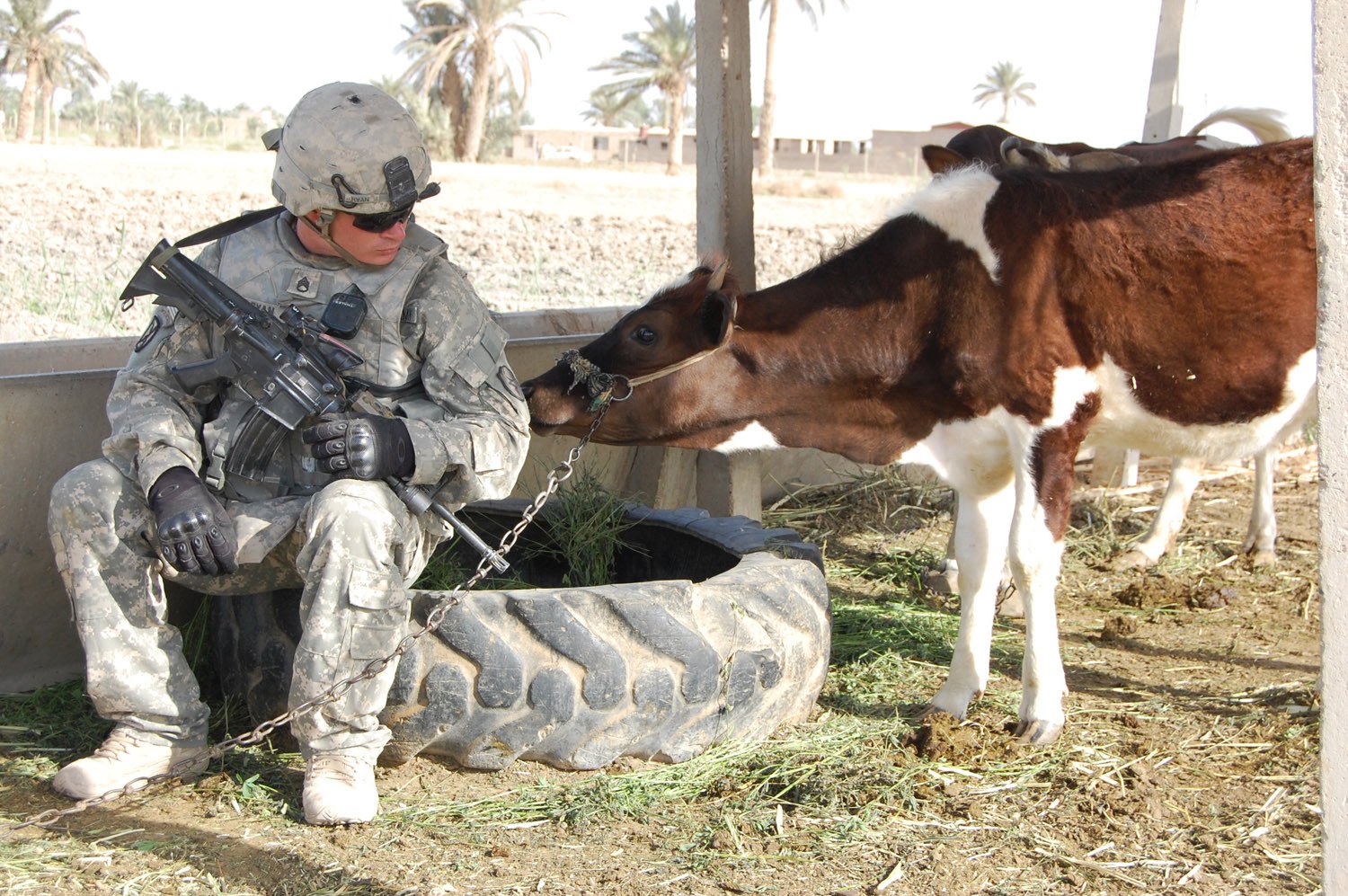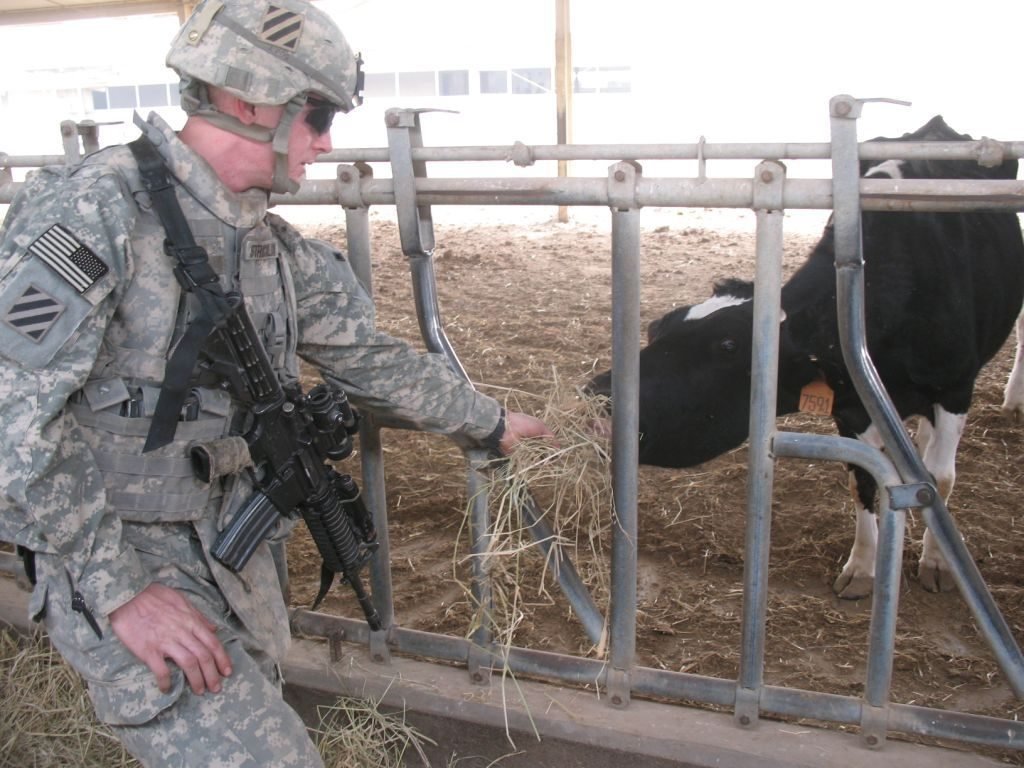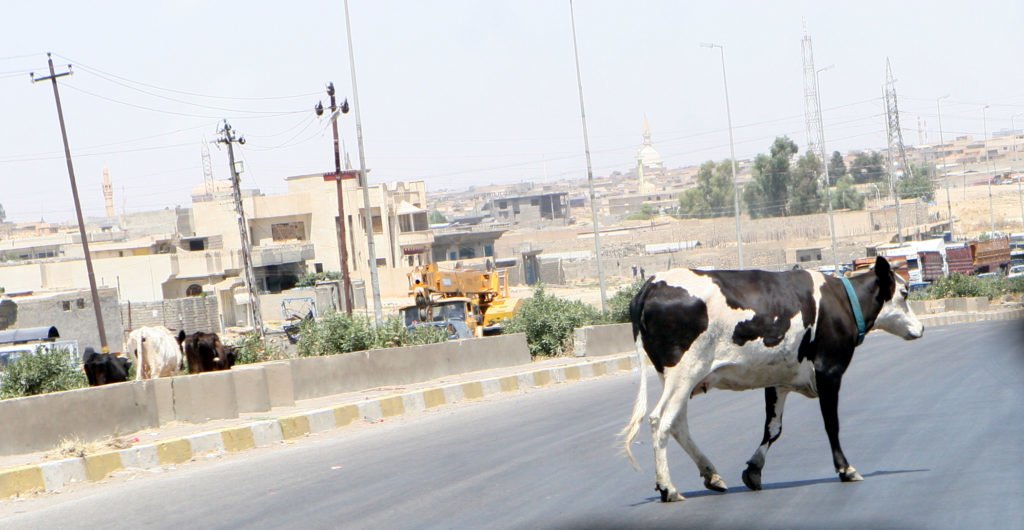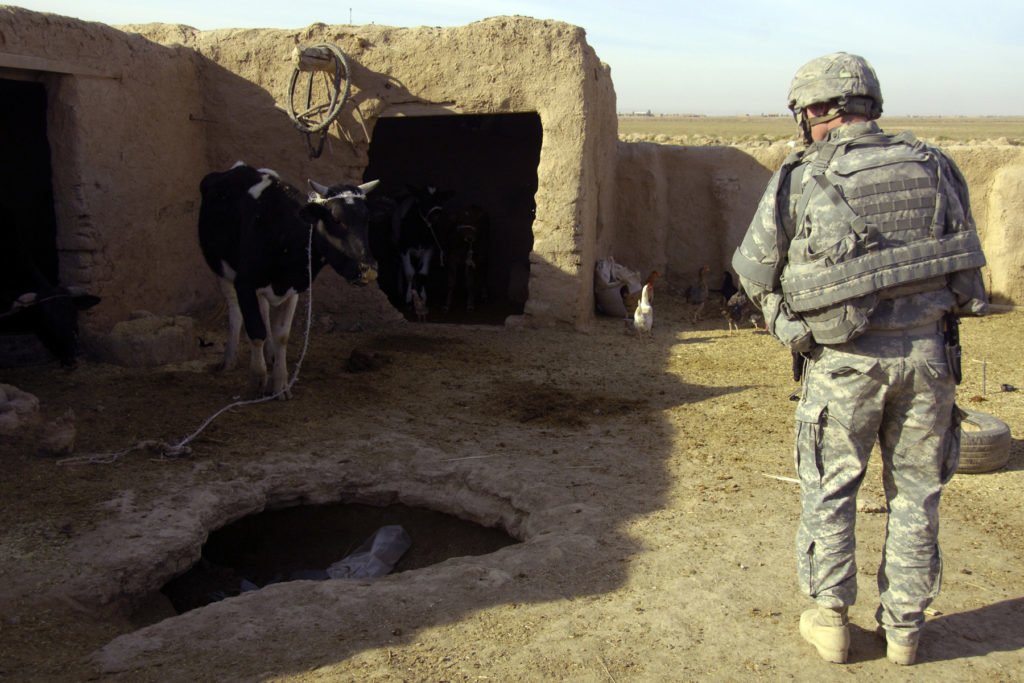That Time a Cow Blocked the Path of Two EOD Techs With 16 Pounds of C-4

Staff Sgt. Chad Ryan, a Sterling, Ill., native, is greeted by a cow while taking a break during a patrol, May 12 in the East Anbar province, northwest of Baghdad. Ryan is a mortar section sergeant assigned to Headquarters and Headquarters Company, 1st Battalion, 27th Infantry Regiment “Wolfhounds,” 2nd Stryker Brigade Combat Team “Warrior,” 25th Infantry Division, Multi-National Division – Baghdad. (U.S. Army photo/Staff Sgt. J.B. Jaso III)
U.S. Army explosive ordnance disposal (EOD) technician Griffin Trenbeath was north of Camp Taji, Iraq, when his team received a call from a unit on Highway 1 (MSR Tampa). Trenbeath had already dealt with multiple incidents on that winter day in 2005, and with the full moon out, the insurgents could see the markers where they’d buried caches of ordnance, making it easier to target U.S. soldiers. The call, like the majority of the others, was about a suspected improvised explosive device (IED) that had been seen on the road by a convoy of Army troops.
“We washed our Otis Spunkmeyer muffins down with the [then] newly introduced RIP IT energy drinks, briefed our security guys on the location of the device, and headed out,” Trenbeath said.
From there, they linked up with the convoy that had called in the possible IED. They had been in country for three months now and had responded to hundreds of incidents, but this was a first: a black cow was lying in half of the highway.

“The bad guys were pretty good at taking deceased canines, eviscerating them, inserting ordnance items in the void, placing them in a way that looked natural on the side of a road, and detonating them as troops passed by. The damage a stuffed dog could do was immense, so a whole cow potentially filled with explosive …,” Trenbeath trailed off.
The team decided on a quick course of action. They were going to countercharge the cow with an M183 Demolition Charge Assembly (satchel charge). Sleep deprived and fueled only by their RIP IT drinks, they figured one of two things would happen:
- If the cow had explosives inside it, about 16 pounds of C-4 would be plenty to detonate the other material, and it would act like an explosive shovel, removing the items and separating the IED components, which would render it safe, or
- If there weren’t any explosives in the cattle, it would still move the 1-ton object.

Trenbeath and his teammate set up their Talon Robot, which is designed to respond to explosive threats, then his team leader briefed the security element in the area on what was going to happen. By the time that team leader made it back, the robot was heading toward the cow, carrying with it the explosive solution to execute the operation.
With the bag of C-4 in position, the security team reversed course from Trenbeath and his teammate. They were out in the open. Still, the security team was watching their six, so no sniper was going to get lucky.
“Fire in the hole, fire in the hole, fire in the hole!” Trenbeath yelled.

A millisecond later, cow was everywhere.
“I’ve seen aftermaths of suicide bombings, shoveled burning remains from hummers, busted my ass from stepping in brain, but the burnt, rotten bovine takes the cake for nightmarish smells,” Trenbeath said. “Words cannot accurately describe it — but imagine the smells of singed hair, shower drain hair removal, two-weeks-past-its-date milk, a full diaper, and a thousand unflushed stop commodes.”
The one cow had become a thousand 1-pound pieces. It was stuck in power lines, on their truck, beyond their vehicle — everywhere imaginable. The largest chunks remained right in the middle of the road and needed to be towed away.
“While tying a line around the shreds of bone and skin — and through our laughter — I must have lost my own guts three times,” Trenbeath said. “The cow remained in my hummer for weeks — and in my head forever.”

Justen Charters is a contributing editor for Coffee or Die Magazine. Justen was previously at Independent-Journal Review (IJ Review) for four years, where his articles were responsible for over 150 million page views, serving in various positions from content specialist to viral content editor. He currently resides in Utah with his wife and daughter.
BRCC and Bad Moon Print Press team up for an exclusive, limited-edition T-shirt design!
BRCC partners with Team Room Design for an exclusive T-shirt release!
Thirty Seconds Out has partnered with BRCC for an exclusive shirt design invoking the God of Winter.
Lucas O'Hara of Grizzly Forge has teamed up with BRCC for a badass, exclusive Shirt Club T-shirt design featuring his most popular knife and tiomahawk.
Coffee or Die sits down with one of the graphic designers behind Black Rifle Coffee's signature look and vibe.
Biden will award the Medal of Honor to a Vietnam War Army helicopter pilot who risked his life to save a reconnaissance team from almost certain death.
Ever wonder how much Jack Mandaville would f*ck sh*t up if he went back in time? The American Revolution didn't even see him coming.
A nearly 200-year-old West Point time capsule that at first appeared to yield little more than dust contains hidden treasure, the US Military Academy said.












